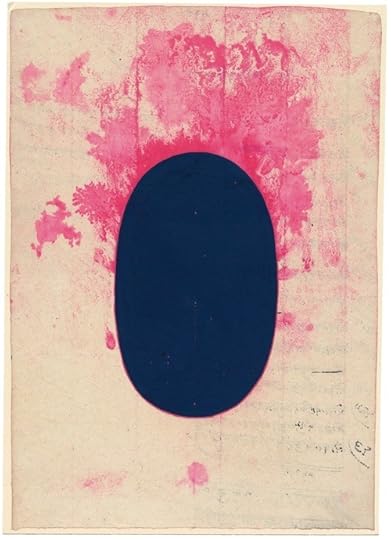"An Egoless Practice": Tantric Art
Bikaner, 2002, 14'' x 10''. Simply the king. The Shiva linga, the original representation of the deity. Sign among signs (in Sanskrit linga means "sign"). In the form of a man's member: joyful, erect, and sometimes so impassioned that, in the ritual, according to André Padoux, "it must be continually watered to cool it down." A sacred thing among things, and always present in the temple, as well as in those small sanctuaries located in family estates, and in the intimate secrets of peoples' homes. A body surrounded by vapors—another clear sign that a flame burns eternally within.
It could be a cult classic: the debut edition of Siglio Press's Tantra Song—one of the only books to survey the elusive tradition of abstract Tantric painting from Rajasthan, India—sold out in a swift six weeks. Rendered by hand on found pieces of paper and used primarily for meditation, the works depict deities as geometric, vividly hued shapes and mark a clear departure from Tantric art's better-known figurative styles. They also resonate uncannily with lineages of twentieth-century art—from the Bauhaus and Russian Constructivism to Minimalism—as well as with much painting today. Rarely have the ancient and the modern come together so fluidly.
For nearly three decades, the renowned French poet Franck André Jamme has collected these visual communiqués, and it hasn't been easy: in 1985 he survived a fatal bus accident while traveling to visit Hindu tantrikas in Jaipur. In Tantra Song, Jamme assembles some of the most pulsating works he's acquired, while unpacking his experiential knowledge of Tantra's cosmology.
Western views of Tantra tend toward hyperbole. (The New York Times recently published an article, "Yoga and Sex Scandals: No Surprise Here," noting, "Early in the twentieth century, the founders of modern yoga worked hard to remove the Tantric stain.") Jamme's book serves as a corrective to this slant and sheds significant light on the deep historical roots—and fruits—of the practice. Siglio will release a second edition of the book on April 19. Jamme and I recently discussed these anonymously made paintings, the altered states they induce, and their timeless aesthetics.
The Paris Review's Blog
- The Paris Review's profile
- 305 followers




